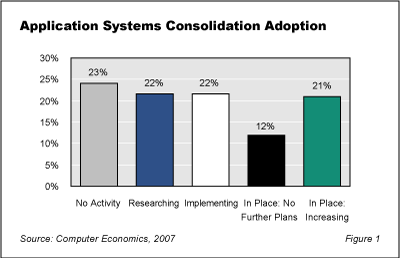Application proliferation is the bane of many IT organizations. There are several reasons for the kudzu-like growth of applications within many organizations–for example, a company may make a series of acquisitions but not have time to move the acquired businesses to a common set of applications. Or, certain business units may resist migration to a corporate platform for fear of giving up control. In other cases, the IT group may be under more pressure to implement new systems than to consolidate the existing portfolio. In addition, some custom applications may be poorly understood by current IT personnel, making it difficult to replace or retire them. As a result, large organizations in particular may find themselves with three, four, or even more major application systems, each providing the same or similar functionality.
This Research Byte is a summary of our full report, Application Consolidation: Adoption Trends and Benefits.
Application consolidation generally takes two forms. The first type of consolidation is the merging of two instances of the same system into a single instance. For example, an organization may have one instance of SAP running in the U.S. and another instance running in Europe. The consolidation effort would combine these two instances of SAP into a single system to serve users in both locations. The second type of consolidation is to merge two different systems with similar functionality into a single system. For example, an organization may be running Oracle’s E-Business Suite in the U.S. and SAP in Europe. The consolidation effort in this case would move all the users to a single application–most likely SAP or Oracle. The second type of consolidation is generally more difficult than the first because it requires a much greater amount of planning, requirements mapping, business process reengineering, and user training.
Although most application consolidation projects involve merging only two or three systems to a single instance, the scale of some projects can be much greater. For instance, Sun Microsystems is in the midst of what is possibly the largest application consolidation program ever attempted: a three-year effort that is replacing 1,000 applications with a single instance of Oracle’s E-Business Suite.
Although the difficulties of application consolidation should not be underestimated, the benefits should be appreciated as well. For example:
- Application consolidation can reduce the number of software vendors and contracts, which cuts licensing costs and simplifies the application portfolio.
- IT staffing requirements are streamlined, as fewer systems need to be supported and there is less need to recruit technicians with hard-to-find legacy skills.
- Processing requirements are reduced because the consolidated systems are likely to run on fewer servers, saving hardware, operating systems, and database licensing fees.
- The overall IT environment is simplified because there are fewer interfaces to be maintained between systems.
- The quality of information improves as data is no longer scattered across multiple databases and applications, each of which may define key information in a different way.
- Workforce productivity improves as there is less need for users to learn and work in as many different applications as they did before consolidation.
The trend toward application consolidation is increasing, and the majority of organizations that begin such initiatives tend to increase their efforts. Figure 1 shows the adoption practices of our survey participants. More than three-quarters have some application consolidation effort in progress. Research is underway at 22% of the respondent organizations, and another 22% are in the implementation stage. Application consolidation has already taken place at 33% of the sites: 12% do not plan further consolidation, but 21% are still increasing their consolidation efforts.

The full version of this report investigates the payoffs and risks associated with application consolidation and provides recommendations derived from our findings. This analysis is based on a Computer Economics survey of more than 200 IT organizations and compares statistics from organizations of various sizes. We also provide data on the return on investment (ROI) that these organizations experience, along with in-depth cost analyses of expected and actual ownership costs of application consolidation. The quantitative effect that application consolidation has on IT budgets is also investigated, finding that organizations undergoing consolidation spend less on application software as a percentage of budget than organizations that report no consolidation. The full report concludes with practical guidelines for application consolidation that mitigate the risks of the effort.
This Research Byte is a brief overview of our report on this subject, Application Consolidation: Adoption Trends and Benefits. The full report is available at no charge for Computer Economics clients, or it may be purchased by non-clients directly from our website at https://avasant.com/report/application-consolidation-adoption-trends-and-benefits-2007/ (click for pricing).

